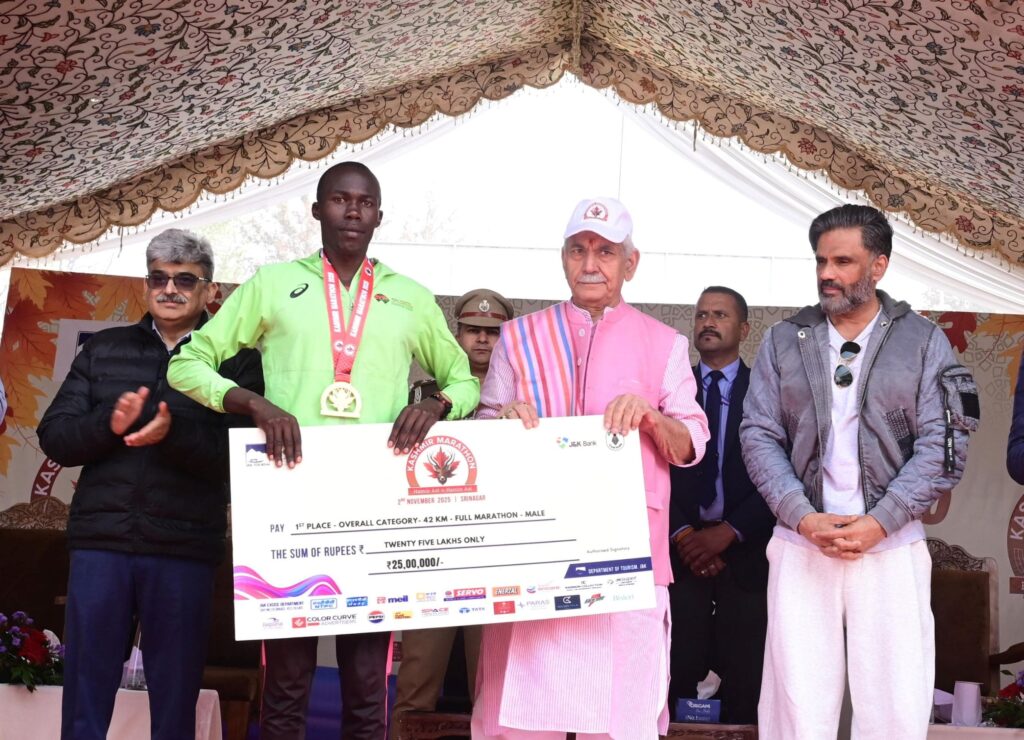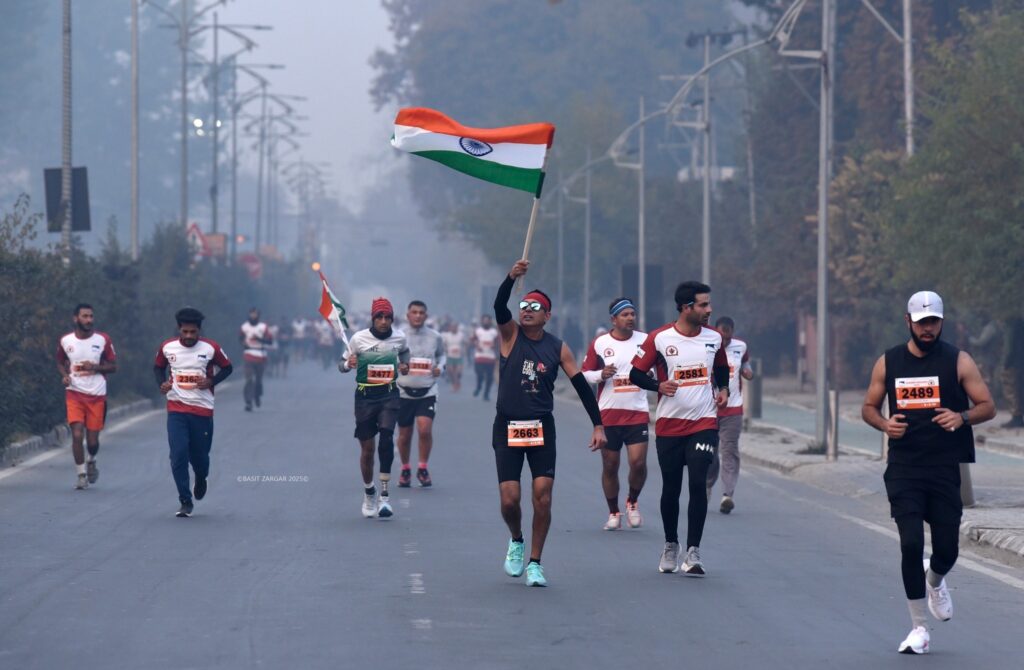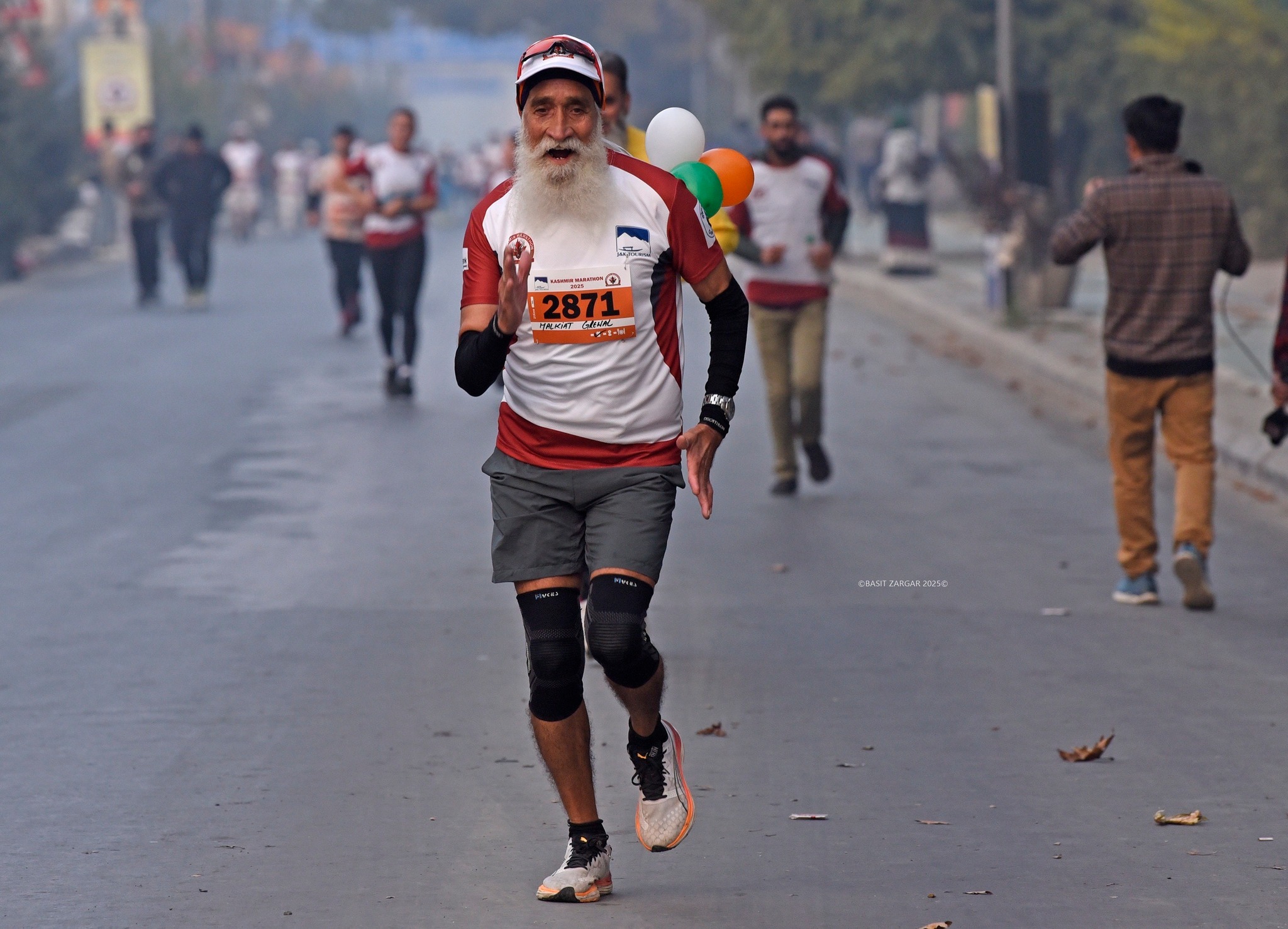By Ajaz Rashid
The 2025 edition of the Kashmir Marathon, dubbed “Kashmir Marathon 2.0,” unfurled as a vibrant testament to the enduring spirit, resilience, and beauty of the Valley. Amidst sweeping security and hopes for tourism revival after the April Pahalgam terror attack, over 1,500 runners from 27 states and 11 countries took to the streets of Srinagar, weaving through the city’s idyllic routes beside Dal Lake, beneath the golden hues of Chinar trees, and along the historic Mughal Gardens. The event, orchestrated by the Department of Tourism in partnership with the J&K Sports Council, not only crowned new marathon champions but also unified communities in a rare spectacle of athleticism, camaraderie, and hope.
The marathon flagged off at 6 am from Polo View — now Srinagar’s first pedestrian-only market — under the gaze of a sizable crowd and a whir of excitement. Chief Minister Omar Abdullah and Bollywood actor Sunil Shetty led the ceremonies, with the chief minister himself donning his running shoes and joining the half marathon. Abdullah completed his race, sharing on social media, “I didn’t set a personal best but did improve on my effort last year. Congratulations to all the runners who completed the full marathon & the half marathon. Well done #KashmirMarathon”. His participation, along with several senior bureaucrats and local celebrities, sent a resonant message of normalcy and aspiration to locals and outsiders alike.

The main event offered both a full marathon (42 km) and a half marathon (21 km), with shorter fun runs for amateurs and local families. The prize pool, reportedly pegged at ₹25 lakh for top finishers, heightened the competitive spirit, drawing elite athletes from countries including Kenya, Ethiopia, Germany, Denmark, the USA, Japan, and Sri Lanka. The full marathon concluded at Hazratbal, winding through traffic-restricted scenic lanes — a logistical feat under heavy security — while the half marathon ended at Makhai Point, a landmark overlooking the shimmering waters of the Dal.
This year’s edition arrived under the shadow of the April 22 terror incident in Pahalgam, which saw 25 tourists and a local pony handler killed, devastating the local tourism industry. As such, the marathon became a purposeful avenue for the administration to project resilience and optimism. “No matter what terrorism does, it cannot break the spirit of Jammu and Kashmir. The aim is to boost national and international tourism,” stated Director of Tourism Kashmir, Raja Yaqoob. Deputy organizers added that holding the event so soon after such tragedy was “essential for Kashmir’s revival and for restoring confidence among residents and visitors alike”.
For the early-morning hours of November 2, the streets turned festive — security was tight, but locals gathered along the route, waving at runners and cheering from balconies. Volunteers handed out water bottles and energy packs as runners passed famed city landmarks like the Shankaracharya Temple, Pari Mahal, and Dargah Shrine, offering a live tableau of Kashmir’s rich culture and natural opulence. The Mughal Gardens’ meticulously designed landscapes and the changing Chinar leaves provided an arresting autumnal backdrop, enchanting especially the international athletes, who described running through Kashmir as “a run in heaven”.

Winners in the men’s and women’s categories received special recognition at an elegant closing ceremony attended by Lieutenant Governor Manoj Sinha. While some details on finishers were still emerging, local and international runners alike dominated the podium, highlighting the growing prowess and global appeal of the event. Diskit Dolma, a notable name in local running circles, clinched a silver medal in the 21 km category, while other regional talents like Manzoor Hussain and Stanzin Dolkar also won top honors in their categories. Manzoor Akhoon, cheered as a crowd favourite, was among those highlighted for his perseverance and strong finish.
In his address, the Lieutenant Governor emphasized the unifying force the marathon had become: “The soaring spirit of 1,100 runners is a testament to the marathon’s ability to unite people and strengthen brotherhood through shared experiences. Within two years since its launch, Kashmir Marathon has infused a sense of pride and passion among people, inspiring a new generation of runners”. He further expressed confidence that with growing participation, the marathon will act as an economic catalyst for the region’s battered tourism sector.
“Jammu Kashmir is a crown jewel of India with rich heritage and vibrant culture. It is a paradise on earth known for its natural beauty and ageless ideals of humanism, communal harmony and peace. I am grateful to Hon’ble Prime Minister Narendra Modi Ji for the historical transformation in this land to build a Jammu Kashmir, which harmonizes modernity and spirituality and today it is moving forward with unwavering passion and resolution,” the Lieutenant Governor said.
Bollywood star Sunil Shetty’s presence added a dash of celebrity energy. “It’s a great initiative, and I feel lucky to be associated with it,” he said. “This marathon is crucial for Kashmir’s tourism, especially after the Pahalgam attack. The event sends a positive global message about Kashmir’s potential as a film destination and tourism hub”. Shetty also underlined how several film productions were currently ongoing in the region, signaling renewed national interest in Kashmir’s landscapes and hospitality.
For the runners, the experience transcended competition. Many spoke of “awe-inspiring scenery” and “overwhelming warmth from Kashmiris welcoming them along the route”. For first-time participant Stanzin Dolkar, who took home a medal in the 10 km race, the marathon was a “dream run, where every kilometre felt like a new painting of culture and peace”. Amateurs and seasoned runners alike spoke of a “sense of common humanity and shared triumph” as they braved the undulating terrain of the Zabarwan range and the biting November chill.

Security arrangements were notably tight, with the J&K Police and civil administration collaborating for smooth conduct of the event. The city’s traffic was rerouted, major roadways were heavily guarded, and emergency medical response teams dotted the course — precautions that allowed the event to proceed without incident. This efficiency, organizers said, sent a strong message about the Valley’s readiness to welcome major sporting and cultural events in the months ahead.
Preliminary bookings for the winter sports season in Gulmarg are already showing signs of revival; officials attribute the uptick to sustained media coverage of the marathon’s positive imagery.
For many, the sight of hundreds running in harmony along the Jhelum embankments and through bustling markets was both symbolic and aspirational. “We are back in a big way,” Sunil Shetty enthused, echoing the hopefulness voiced by athletes, local officials, and ordinary Kashmiris who thronged the finish line. Social media buzzed with selfies, race numbers, and behind-the-scenes moments, further amplifying the event’s impact across platforms. Hashtags like #RunForKashmir, #KashmirMarathon, and #ValleyOfHope trended locally for hours.

Organizers have already announced plans for next year’s marathon, with ambitions to double the registration and rope in more international sponsors. The event’s website promises an even more elaborate festival in 2026, with added categories for differently-abled athletes and expanded cultural programming alongside the main race.
As dusk settled on November 2, amidst the echoes of celebratory cheers and the quiet pride of finishers clutching their medals, the Kashmir Marathon 2025 stood out as more than a race. It became a vibrant affirmation of a valley’s life-force — a run for fitness, for tourism, for peace, and above all, for a future unbowed by fear.

Leave a Reply